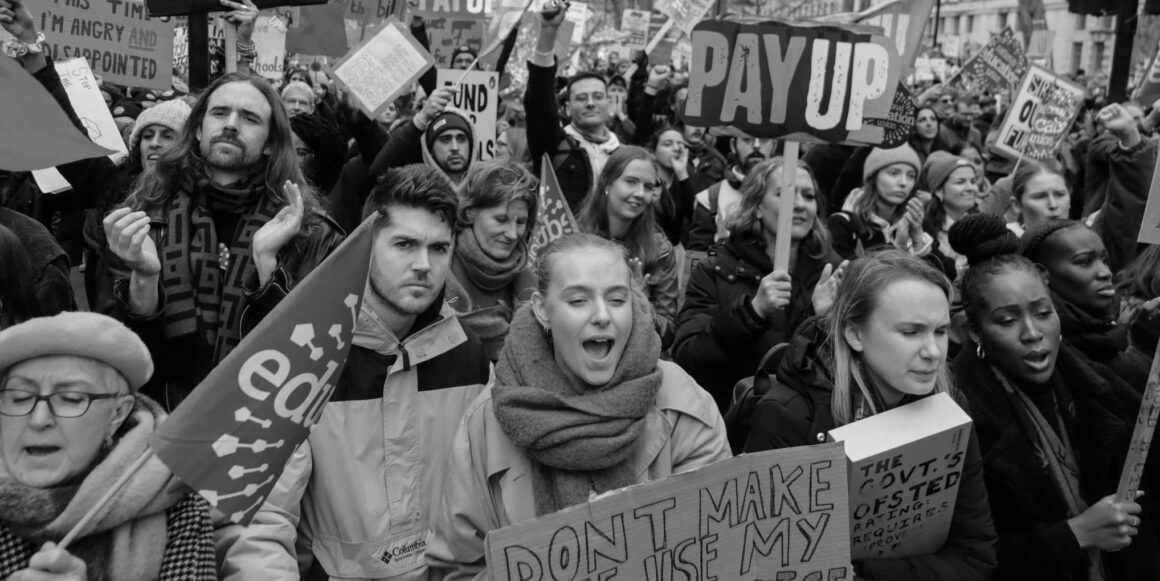

By KD Tait
ON 1 FEBRUARY hundreds of thousands of teachers, lecturers, civil servants and train drivers struck in the biggest coordinated day of action for many years.
In London alone, 50,000 strikers marched in the biggest weekday demonstration since the protest against Donald Trump’s visit in 2018. Tens of thousands more marched in towns and cities across the country.
Trade unions are demanding pay rises that address the cost of living crisis. Inflation rates of more than 11% on top of a decade of pay freezes mean the real value of millions of public sector workers’ wages is lower than it was in 2010.
Crisis
But these strikes are about much more than pay. Everyone can see that a decade of austerity, privatisation, and the economic hit from Brexit have all left public services on the brink of collapse. For the Tories, this is a step towards ending universal, free at the point of use, public services. For those on strike, this action is about protecting jobs and working conditions—fighting for fully funded public services we all rely on.
The privatisation of health and education, the impoverishment and punishment of the unemployed, the catastrophic state of our public transport, the wastefulness of working conditions so degraded that tens of thousands of expensively trained, newly qualified teachers and nurses quit within the first two years, are all reason enough to strike.
But there’s more. The government is using the strikes to pass even more draconian anti-strike laws which will effectively end the right to strike in health, transport, education and emergency services.
It’s not just about public sector workers. Pay in the private sector is lagging well behind inflation, but pay rises are still running at double those in the public sector. The government wants to hold down public sector pay to set a benchmark for the wage bill as a whole.
The stakes are high for everyone. Pay, pensions, access to healthcare and education, and the right to strike are all under threat. The 1 February action was impressive. To get it organised meant a sustained organising effort in the unions, recruiting tens of thousands of new members, and hundreds of reps and activists. The demonstrations reflected a younger, more diverse membership, well aware of the political implications and stakes.
Strategy
But the central question: ‘where next?’ means asking whether the trade union leaders’ strategy is working.
Firstly, those striking on 1 February were let down by the RCN union, whose leader Pat Cullen insisted she would not back any joint action, because she only represents nurses. Hiding behind this ‘mandate’, is narrow sectionalism – putting the interest of one group of workers ahead of a collective effort and thus weakening all.
Worse, planned negotiations with employers were used as an excuse by the CWU and RMT, whose leaders Dave Ward and Mick Lynch have been the most high-profile advocates of coordinated action, to stand aside from the action (with the exception of a small number of train drivers). In neither dispute have the employers made any offer that comes remotely close to justifying this decision. It weakened their dispute as well as everyone else’s.
The Tories are playing divide and rule, and the refusal of the TUC and the leaders of the main unions to build a united coalition that uses the power of the strongest to help win the claims of the weaker, is helping them. For these trade union leaders, our movement’s motto—‘unity is strength’—is just an empty slogan, good for speeches and banners but banned from the negotiating room.
Secondly, and linked to the union leadership’s overriding desire to keep control of their own disputes and avoid them generalising into a political offensive which imposes its own demands, is the strategy of occasional one or two day strikes followed by lengthy periods of negotiations, the aims and conduct of which the members losing pay have no say or knowledge.
The evidence is clear. Against a government determined to prop up the profits of the employers and defend the fortunes of the rich by holding down pay, one-day strikes are not enough to win. At best they will deliver modest concessions for some like nurses and rail workers, dividing the movement and leaving other sections isolated and having to settle for less.
The UCU have announced 18 days of action in February and March, but the NEU are moving to rolling regional strikes. Escalation, moving as rapidly as possible is the only alternative to a long drawn out campaign which leaves the initiative and power with the government, who can simply wait us out.
Thirdly, while strikes are the most effective weapon for organised workers to fight for their interests, the wholesale social crisis which is hammering living standards requires the mobilisation of the working class not just specific trade unions. In every community, we need a social and political force campaigning for action on energy bills, rents, and the rampant profiteering of the big banks and energy companies. Let’s bring together activists from renters’ campaigns, environmental groups, Black and women’s organisations, with trade unionists, to develop a common strategy.
Organisation
In the unions, rank and file activists who recognise the need for a change in strategy need to start meeting, locally, regionally and nationally to work out a plan of action for taking control of the strikes and negotiations.
The next day of action is not due until budget day on 15 March—fully six weeks away. These weeks must prove to be a decisive turning point in the struggle. What is needed is a focused intervention into the movement, to build up rank and file organisation and control, and the unity of the social campaigns like People’s Assembly and Enough is Enough. This strategy, the organisation of militants behind a programme of action to make our movement fit to fight, is what Workers Power members fight for. If you agree, join us.